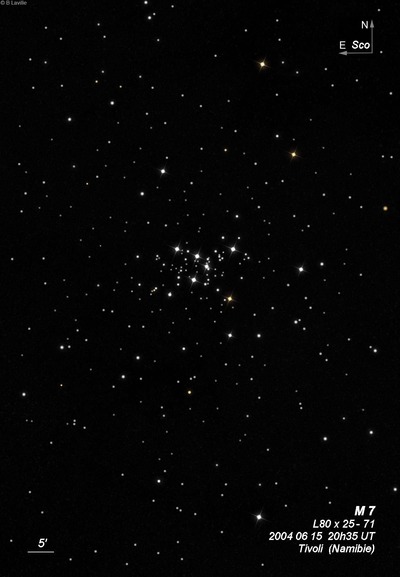Ptolemy's Cluster
Ptolemy's Cluster

Giovanni Hodierna made the first telescopic observation of M7 = NGC 6475 = Lac II-14 = h3710 in 1654 and resolved the cluster into at least 30 stars. Edmond Halley made an early observation of M7 in 1677 from St. Helena while cataloging southern stars and Nicolas-Louis de Lacaille "discovered" it again on 15 Jun 1752 from the Cape of Good Hope, as he unaware of Hodierna's earlier observation. At a declination of -34.7°, M7 culminates only 7° above the horizon from Paris, so Messier's confirmation on 23 May 1764 is impressive. Halley was credited with the discovery in the NGC.
M7 is often referred to as "Ptolemy's Cluster" as it was possibly included in the Almagest as a "nebula following the sting of Scorpius." (found ~138 BC). But David Frew states that G Scorpii is the object described as nebulous as Ptolemy may have accidentally precessed the position of G Scorpii in Hipparchus' catalogue.
200/250mm - 8" overfills 40' field, not many faint stars, scattered.
300/350mm - 13.1" very bright, very large, impressive but scattered, overfills 52' field. Open cluster H18 lies 45' SE and globular cluster NGC 6453 40' WNW of center. Prominent naked-eye cluster in dark sky. Includes several blue-white and yellowish stars.
400/500mm - 18" (7/21/04): at 92x at least 300 stars are visible in the cluster, though very difficult to count due to the very large size (overfills the 42' field). The more concentrated part of the cluster spans perhaps 30' and includes a dozen stars of mag 7.5 or brighter in the main body. This cluster is much larger and brighter (very prominent naked-eye), but it is much more scattered than M6 and so is less impressive. There are several bright, distinctive strings in the cluster including a N-S string of ~8 stars on the east side of the central region. An equilateral triangle of mag 6, 7 and 8 stars with sides of 3' is on the NW side of the core of the cluster. A clump of 5 stars is near the center including two mag 6 and 7 stars. On the south side of the center of the cluster is an 11' string of 5 mag 5.6 to 7.8 stars oriented SW-NE with the bright mag 5.6 star (HD 16258) on the SW end a distinctive yellow color.
Notes by Steve Gottlieb